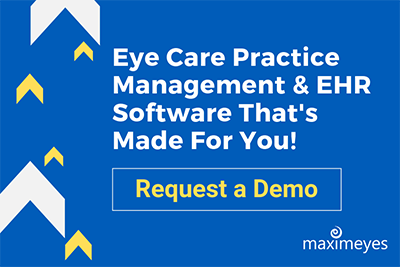
09 Dec How to Improve Patient Flow in 5 Masterful Steps
Why is improving patient flow important for modern eye care practices? At the recent Vision Expo West (VEW) conference, we asked eye care professionals to select all the reasons why patient flow management is critical.
- 73% said improving patient flow keeps their staff happy.
- 76% said better patient flow keeps their patients happy.
- 80% said patient flow management allows them to see more patients per day.
Patient flow management impacts staff performance, patient experiences, and revenue growth. Understand precisely how to improve patient flow at your optometry practice to reap the benefits.
What is Patient Flow Management?
Patient flow is the physical and virtual movement of patients through a healthcare encounter. It encompasses the entire patient experience in your office—from scheduling to check-out, and all of the steps in-between. To avoid roadblocks, use patient flow management as a systematic road map for a positive eye care experience.
Why is Patient Flow Important?
When a patient enters your practice, each point of contact and every step in the process is an opportunity to build trust and gain patient loyalty. A prompt and genuinely friendly greeting at reception, cheerful assistance with paperwork or check-in apps, brief wait times, and knowledgeable staff all leave a lasting, positive impression on your patients.
Patient flow is the foundation of a successful practice. Managed properly, you’ll maximize efficiency, optimize both staff and patient satisfaction and loyalty, and increase revenue.
Top Ways to Improve Patient Flow in Eye Care
1. Get patients there on time.
Late patients cause major issues with patient flow. If a patient arrives late to their appointment, they have to be fit in out of sequence, and it throws the timing off for the rest of the day.
Do your best to ensure your patients arrive on time by utilizing appointment reminder texts. Nearly half of our clients surveyed chose “texting appointment reminders” as the single feature of their EHR system that improved patient flow the most in their practice. Many patients won’t answer the phone or check their voicemail, but they’ll see a text.
Here are more patient scheduling best practices to help with patient flow.
2. Educate and train staff.
A knowledgeable staff leaves a lasting impression on your patients. Stephen M. Montaquila, O.D., F.A.A.O recommends that you “Train your ancillary staff to provide the many aspects of contact lens management, adding to the value of the encounter, while minimizing your chair time.”
Well-trained techs directly impact your ability to optimize exam time and improve patient flow in your practice. Your investment in staff education and training will pay off.
3. Reduce wait times.
Patients don’t like to sit in a waiting room for more than 15 minutes. And, they certainly don’t love filling out paperwork. Use a check-in app and go paperless as much as possible. Have techs take verbal history in the pretesting room, rather than making patients fill out multiple written pages.
Shorten wait time even further by getting patients through pretesting more quickly. Pinpoint the machines that cause the biggest bottlenecks, and purchase duplicate testing instruments. When you reduce wait times, your patients enjoy their visit and spend more time shopping in optical. As a result, you’ll gain their loyalty and increase your revenue.
Further, reduce wait times with these favorite EHR system time-savings features.
4. Assess your space.
What rooms or areas are being utilized for which parts of your patient visits? Remember to use your space to minimize patient time spent in the exam room. Try to keep the exam room strictly for exams. Use all other space to minimize wait times and enhance the patient experience.
Assess where bottlenecks occur and adjust accordingly. Maybe you need a bigger pretesting room to accommodate multiple patients at once. You might consider expanding your optical open space to optimize wait times as a shopping experience.
5. Speed up exam time.
When VEW attendees were asked how their EHR system improved patient flow, nearly 75% cited “instant access to patient data.”
With everything at your fingertips, you spend less time in the exam room and improve face-to-face interaction with patients. Consider using an EHR that has a cloud-based ophthalmic imaging management integration. You’ll be able to view patient imaging almost instantly and share this exciting technology with your patients in the exam chair.
“With all testing and images from different instruments and manufacturers in one location, viewing images side-by-side in EyeClinic Imaging helps me detect changes and annotate images quickly.” – Philip Gross, OD
Transform Patient Flow for Greater Success
Treating hundreds of patients each week is the norm for Greg Caldwell, OD, co-owner of a large four-doctor practice. How does he achieve this while maintaining patient care integrity? One word…efficiency.
Patient flow management is a key strategy for employee satisfaction, patient retention, and revenue objectives. Assess your patient flow experience and uncover ways to transform each step of your process.
Find out how you can master patient flow in your optometry practice with MaximEyes.





